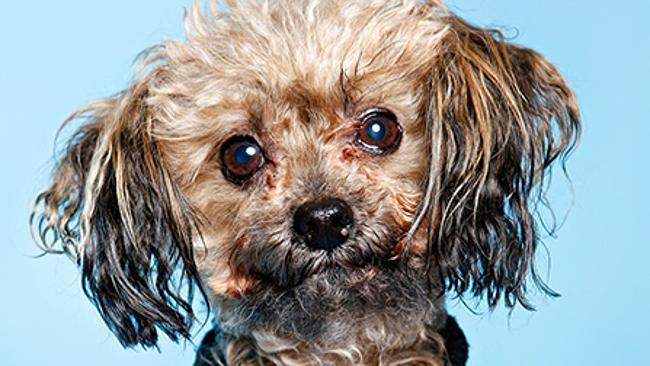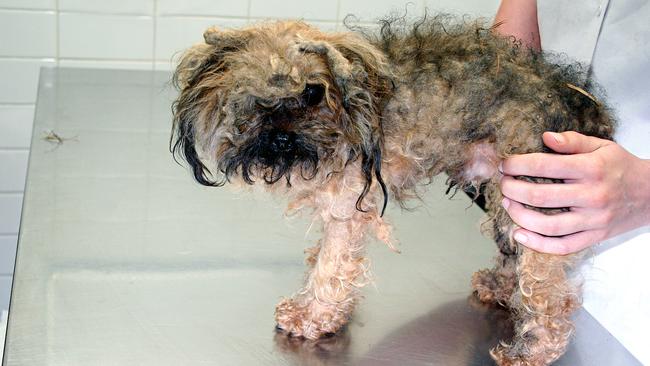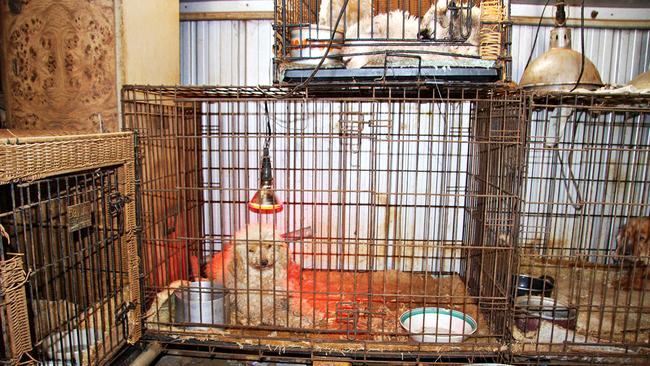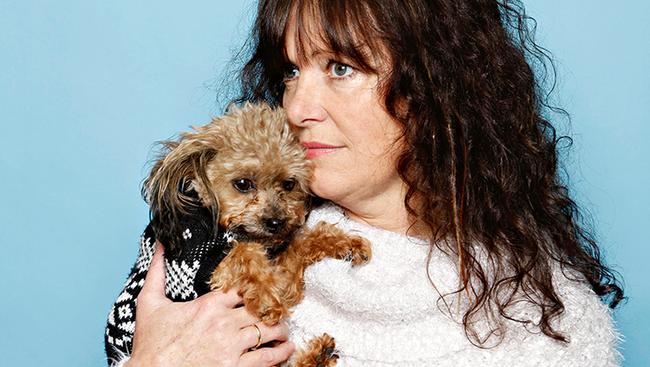Puppy factories: How Oscar the dog inspired a campaign to close them
He’s one tiny dog, yet Oscar’s life helped galvanise a movement to shut down intensive puppy factories.

The stench comes in a rush; stopping the breath, leaving you gasping, eyes streaming. A putrid stench of rotting flesh, faeces, stagnant water. The sting of ammonia fumes from the urine-soaked floors. The stink of terror. Of trapped dogs. Of death.
The shed is out the back, behind the house in Falls Creek, southern NSW. It’s big, with seven rooms and a narrow veranda. Inside it are almost 200 dogs — german shepherds, labradors and small, trendy breeds such as Shih tzus — locked in crowded cages piled on top of each other, living in their own filth. They aren’t all alive. In one room a number of puppies are tied together with electrical wire; some have died from strangulation. In another room lie more dead puppies in plastic bags and fridges. In another is a Shih tzu bitch trying to give birth but her puppies are stuck in the birth canal. The fumes are so noxious that it’s too dangerous for humans to remain in the shed for long and extractor fans have to be brought in.
“The smell was putrid, rotten,” says RSPCA NSW chief inspector David O’Shannessy. “It was one of the worst places we’ve ever seen. The conditions were dangerous for us to remain in, but the dogs had lived like this for at least six months. There was little ventilation, their food was rotten; they were in pain, distress and suffering. We had to euthanase a number.”
If they hadn’t been rescued, many of the surviving puppies would have been washed off, given a dusting of talcum powder and sold for hundreds of dollars through pet shops, websites or Facebook pages with no care for the problems they could cause their new owners — disease, genetic disorders, behavioural problems. The rest would have remained as breeders, pumping out litter after litter, becoming sicker and sicker until their litters reduced from eight puppies to six, to four, to one, to none. Then they’d be killed. If their owner used the method of other unethical breeders, death would have come with a hammer blow to the head.
The owner was convicted of more than 40 cruelty charges in 2009, fined $155,000 and banned from owning dogs for 10 years. But the NSW RSPCA think he may be back in business in another state, joining the other puppy farmers, thought to number in their hundreds, around Australia exploiting this lucrative, shady industry.
It’s an industry at a flashpoint. Governments grappling with regulation complete reports and inquiries that are slowly leading to tighter laws. Legitimate dog breeders feel under siege from animal activists who take the law into their own hands, illegally entering properties to gather evidence and rescue — some say steal — animals. Pet shops feel they are unfairly targeted and some are forced out of business. Meanwhile, the puppy factories keep churning out pets for an unsuspecting public.
Australia is a nation of animal lovers: 63 per cent of us are pet owners; of that number, 40 per cent own dogs and we spend nearly $3 billion a year on them, according to the Australian Companion Animal Council. Dog owners will tell you of the joy their pet has brought them. Some will also tell you of the unexpected problems: the puppy that died of parvovirus weeks after it came home from a pet shop; the dog, collected in a car park from the breeder, that needed $1000 of dental work done within a week of purchase; the animal that, despite being so young, was so aggressive it had to be euthanased.
These sadder stories are often from people who have unwittingly bought their dogs from intensive breeding operations known as puppy factories. Thousands of us purchase our animals this way because we’ve given no thought to where the dogs have come from, as if a puppy’s life is an empty space before they come into our homes.

Elvis, a rare field spaniel, was rescued from a puppy farm in Bankstown, Sydney, four years ago. He still doesn’t like being around other dogs, is wary of humans and whenever he’s anxious walks round and round in circles, the way he used to in his cramped little cage where he was used as a breeder for the first three years of his life. Elvis was one of 17 dogs rescued from that place; most of the others discovered there were so diseased and damaged they had to be put down. Elvis had a bad ear mite infection and his hair was so matted he had to be completely shaved.
But he survived and was sent to Mel Jones, who assesses such dogs for the RSPCA before they are rehomed. “When I went to pick up Elvis, I was told that he was so conditioned to being kept in a cage I would have to cage him too,” says Jones. “First I put the cage in the lounge so he could be part of everything but he hated it. So I put the cage outside on the back deck and he went straight in. Then he wouldn’t come out. He just sat there quivering. My dogs terrified him; I terrified him. For the next week that’s where he stayed. I could coax him out to ablute but other than that, it was back in the cage. I even had to feed him in there. The first time I took him to the park, he just stood there. He lifted up his feet and put them down, but didn’t move. He didn’t know what grass was.”
Jones has seen many dogs like Elvis. “They’re rejected from birth,” she says. “Their own mothers were born on puppy farms so they have no idea what they’re doing with their litters. They’re too exhausted, sick and in pain to care for them. They push the puppies away from them; there’s none of the licking that gives the puppies their first important contact. They get no warmth, no care, no affection. Then, when the dogs are a few weeks old, they’re given a quick wash and some talcum powder to cover up the filth and they’re sent to the pet shop or advertised online. And a few months later, all the problems — physical, psychological — are visible. Many end up at rescue centres because their owners can’t cope.”
No one knows quite how big the industry is because for the most part it’s an underground business, the breeders working clandestinely in remote areas far from watchful eyes. “We simply don’t understand the size of the puppy trade,” says Steve Coleman, CEO of RSPCA NSW. “There are a lot of broken dogs out there.”
In May, the full horror of puppy factories came to light when a Victorian family pleaded guilty to 240 charges of animal cruelty. They received a hefty fine but escaped jail. Some 235 dogs were kept at the Pyramid Hill farm and many were malnourished and suffered from ear infections, dental disease, heart problems and skin conditions. Yet the puppies presented a lucrative opportunity. Over two and a half years, the family sold 570 to pet shops for more than $250,000.
Between 2010 and 2015 the NSW RSPCA received 132 complaints about dog breeders, 43 of them this year, of which likely half will lead to prosecution for cruelty. Figures are similar in other states, and the number of reports has grown with public recognition of the problem. But insiders say this is just a tiny proportion of the breeders who are running lucrative mass breeding operations across the country.
It is almost impossible for authorities to keep track of them. They set up their operations in remote locations and seldom stay in one place. A breeder may be closed down in one state only to cross the border and open in another — or start again under a different name.
Animal activist Debra Tranter, who has campaigned for 20 years to shut down the mass puppy trade, tells me of a woman whose dogs were so malnourished they were brain-damaged. They were all surrendered to the RSPCA but she moved to a more isolated area in Victoria and opened again under a different name. “It’s common,” she says. “It’s the way these people work.”
Loopholes in the legislation allow puppy farms to thrive. As the RSPCA points out in its 2010 discussion paper, “Nominal efforts by the operators to meet the minimum (albeit inadequate) standards set by regulators make it difficult to mount a prosecution case.”
“I go to at least one puppy factory a month,” Tranter says. “We report them to the local council or the RSPCA, depending on which state we’re in and which laws they are violating. But I’ve been involved in only about five prosecutions over the last 10 years despite overwhelming evidence of cruelty and neglect. It speaks volumes about how weak animal protection laws are.”
Lobbying by Tranter, the RSPCA and other animal welfare organisations resulted in the recent NSW government inquiry into the puppy trade. The Companion Animal Breeding Practices in NSW inquiry heard atrocious tales of animal cruelty; how animals lived and died in appalling conditions, suffering from mites, mange, flesh-eating infections. It heard how unsupervised breeding can lead to broken penises and mauled dogs; how some bitches become so psychotic from having litter after litter removed that they resort to maternal cannibalism, eating their newborn puppies. It heard that the intense inbreeding of puppy mills results in exaggerated congenital disorders and the lack of kindly human contact or socialisation with other dogs mean that they may never be able to settle within a family. And it heard that the life span of factory dogs is brutally short, three or four years at most — forced to start breeding as early as six months old and killed once their usefulness wears out.
The final report, released last month, recommended the introduction of a breeders’ licensing scheme for all commercial dog and cat breeders and the requirement that breeder identification and animal microchip numbers be displayed when advertising the sale of dogs and cats. But it doesn’t go as far as some people wish: there’s no move to ban animal sales in pet shops or restrict the numbers of animals kept by breeders. Animal welfare groups have expressed frustration at what Tranter describes as “a tragic missed opportunity”.
The government has six months to reply to the report. But as Coleman points out: “There’s a big gap between recommending something and implementing it. And we’ve been disappointed before. We now need the public to pile pressure on the government to pass these recommendations. We’ll never end the puppy trade; but if these do go through, at least we’ll have dragged it into the light.”

The trail to the NSW inquiry started in a pine forest on the outskirts of Ballarat, Victoria, two decades ago. Debra Tranter had received an anonymous call telling her of a farm where hundreds of dogs were being kept in atrocious conditions and bred for the pet industry. Back then, no one had heard of puppy breeding; battery farming was for chickens, not dogs, and more experienced voices in the animal welfare world advised that the call was probably a hoax. But something in the caller’s voice persuaded Tranter she was genuine and she spent the next 12 weeks fruitlessly searching the forests around the city.
Until one weekend. “I had gone out there with a friend and we were just walking and chatting; we’d done this every weekend for so long we didn’t expect to find anything. But then we heard barking …” They followed the sound to the edge of a cliff and looked over. Below them were hundreds of dogs in small pens, all pacing the same figure of eight pattern, barking, whining, crying. “We just sat and stared for hours. We couldn’t comprehend the number of animals below us [1000, they found out later]. When it got dark, we entered the property but there were so many different areas, we ended up getting lost. We couldn’t believe what we saw: dogs living in 44 gallon drums, under pieces of tin — matted, sick, broken.”
The women filmed the animals, then went back to Melbourne and released images to the media. These were the first photographs ever seen of a puppy farm and it was big news at the time but Tranter, like most others, thought she had stumbled on the only puppy farm in the country. “There were so many dogs; it was so difficult to comprehend how enormous this property was. I thought this place must be supplying every pet shop in Australia. So for the next 10 years we focused on closing down that one farm.”
Tranter began receiving tips and phone calls from around the state, including from workers at puppy factories who were shocked by the conditions of the animals they cared for. “Eventually I came to realise this was a massive issue and not just a one-off,” she says. It was the start of her odyssey, which has culminated in Oscar’s Law — her campaign to end dog factories. And it’s named after Oscar, the dog Tranter had to rescue twice.
The first time Tranter removed Oscar from a puppy farm in Victoria, he didn’t look like a dog. He looked like a rug that had been rolled up, swamped in effluent and left to rot. Oscar’s hair was so matted he had to be sedated before it could be shaved, exposing the grass seed abscesses that covered his body. His teeth were rotten, his gums diseased and his ears were dangerously infected. Tranter found him huddled at the back of his pen, shivering, terrified, at the farm in a remote part of Victoria with scores of other dogs in similar condition. She’d come to the farm in secret to film the dogs and alert the authorities to their atrocious living conditions. She didn’t intend to remove any dogs but she swept Oscar up and took him home, got him to the vet and started the repair job on the sick little puppy.
A week later, while Oscar was still recovering from surgery, the police arrived at her home, took him from her arms and returned him to the puppy farm. Tranter, who had entered the property illegally to film the animals, was convicted of theft and fined $1500. She brushes this punishment aside. “That night was the most traumatic I’d been through. I felt that I had failed Oscar. He had experienced freedom and love for such a short time and now he’d gone straight back to the awful conditions I thought I’d saved him from.”
The second time Tranter saved Oscar was 18 months later, when sources told her his breeder was selling some dogs. Disguised in a blonde wig and sunglasses, she visited the farm and went back into the shed where Oscar was again living in the filth. He had been shaved bald and was huddled against the back wall, shivering the way he had when she first saw him. But he came to her instantly and pushed himself into her arms. “I want this one,” she told the workers. They tried to dissuade her but she insisted, and they charged her $400. Then she paid another $100 each for the other puppies they were selling and took them all home.
“Oscar was a basket case, an absolute mess. When I got him home he was shaking, he was hunched up, he couldn’t walk upright. It took him ages to get used to being in a house. He didn’t want to be put down; as soon as I did he scratched to be picked up again. He was constantly in my arms. It took two to three months before I could even take him out to
the back yard. It took a while to get him
to where he is today.”
Today Oscar is sitting in my lap, his head in my palm, trusting of this stranger in his home. We’re in Tranter’s office at the foot of the Dandenongs in Victoria, from where she runs her crusade. Over her 20 years of campaigning she has often worked on the other side of the law, a thorn in the side of the authorities, viewed with suspicion by accredited canine associations. She has put her life aside on the way, leaving a successful nursing career and an unsuccessful marriage on the sidelines to concentrate on
the puppy trade.
Slowly, she has gained respect. She has lobbied for the laws in Victoria to be tightened and has been so successful that puppy farmers there are finding it hard to stay in business. It is also in large part thanks to her lobbying that the NSW inquiry was held. “Debra and I have had our debates over the years,” says Steve Coleman. “And I can’t condone her methods. But there’s no doubt that the NSW government inquiry has happened in part because of her work.”
Tranter’s office is spartan. We walk around looking at the photographs on the wall as she tells the grim stories behind them. Here is a dog that’s almost unrecognisable as an animal, whose hair is so matted it has fused to its legs, leaving her crippled and blind, so damaged she had to be euthanased. Beside her is a bitch that had been forced to have so many litters her belly is dragging on the ground, swollen with mammary tumours. “The staff [at the puppy farm] told me that after every litter was taken off her she would sit and howl for days,” she says.
“I was in a puppy farm one day and I saw a bitch in terrible condition, with eyes that were gummed closed. I said, ‘Why are her eyes all gummy?’ The woman just shrugged and answered: ‘They don’t need eyes to pump out puppies.’ That woman was a registered breeder in NSW, supplying a pet shop in Hawaii; she was exporting large numbers of puppies, and it was huge money. For a puppy farmer like that to treat an infection is a waste of time. And as the dogs get older, one of their female puppies has already been put aside to replace them so it doesn’t matter if they die.”
Tranter’s passionate campaign has made her many enemies. It has taken her into dark places and has led to death threats against her and Oscar. “There were a couple of years when I questioned being involved with Oscar’s Law. But I can’t stop. This is so important to me; it’s taken over my life. I’m transported back to the sheds in everything I do and see. Seeing someone walking their dog in the park will immediately take me back to the sheds, thinking of the dogs that will never experience life the way they should.”

Steve Coleman says reputable breeders exist, although he stresses that the RSPCA does not “approve” any breeding operations (some pet shops claim they source their puppies from “RSPCA approved” operations). But he believes dog owners should take responsibility for the animals they buy. “People will spend thousands of dollars for these dogs, only to find they are suffering enormous physical and psychological problems. It astonishes me that people will ask more questions and do more research on the car they’re buying than on the pet that will be with them for the next 15 years.”
So how to be sure you are getting a dog from a legitimate breeder? Visit the facility and check it out for yourself. A good breeder will insist you visit the facility and get to know the dog’s parents months before you pick up the pup. Often they ask you to come back and bond with the new puppy before you take him home.
Some puppy farmers give themselves an air of legitimacy by registering with a breeders’ club or association, or with the local council, but this doesn’t guarantee a high standard of welfare. Others promote themselves through websites that show none of the horror of the reality. But associations are tightening membership rules, and legislation is also slowly being tightened. If the NSW inquiry recommendations are taken up, authorities will be able to trace all breeders and pet owners will know where their animals came from. In Victoria, new legislation will allow councils to seize animals from breeding businesses if the owner isn’t registered or if they’ve been found guilty of animal cruelty. Mandatory vet checks before and after each litter will be introduced and the crackdown will include $5 million of extra funding for the RSPCA’s special investigation unit. In the ACT, legislation passed earlier this year will criminalise the intensive breeding of female dogs and cats. South Australia and Western Australia are reviewing their laws.
Puppy farmers do their utmost to stay one step ahead of the authorities and many will succeed — as long as there is demand. A University of Adelaide study of new dog owners last year found that 29 per cent sourced their puppies online, 44 per cent went directly to a breeder, eight per cent through friends or family and five per cent from a pet shop. Organisations such as the RSPCA encourage people to buy rescue dogs rather than go to breeders. It has partnered with petshop chain Petbarn to help find homes for shelter animals, and over the past three years 4200 have been housed around the country, and they hope this number will grow. In the meantime Tranter, and others like her, will continue working to expose the trade and have it closed down.
I ring her while she’s on her way to pick up two factory farmed dogs who were so terrified when she first saw them that they froze “like statues”. She tells me she’s trying to track a man who has been prosecuted under the Prevention of Cruelty Act and banned from operating in Victoria but who, she has been told, is trying to transport 120 dogs across the border to NSW to start up his business again. She tells me that William, another of her dogs rescued from a puppy farm, has gone suddenly blind and she doesn’t know if it’s just awful luck or because of the appalling treatment he received in the puppy factory. She tells me she’s exhausted. “I’d love not to have to do this anymore. I still break down in the middle of the night, start crying when I’m driving alone. But things are starting to happen. We’ve really pushed the envelope but it’s having an effect. We are putting people out of business.”
Last year, Tranter went back to Ballarat, back to that first farm, the farm of 1000 dogs. “It was just eerie. The dogs’ pens are still there, the sheds are still there; weeds have grown out through the wire. It’s like the day I went in. Nothing had changed.”


